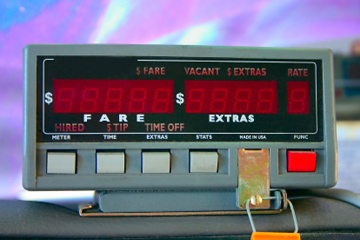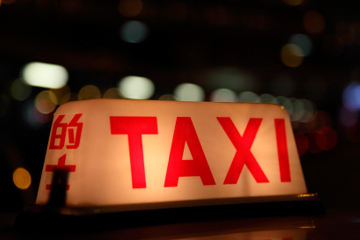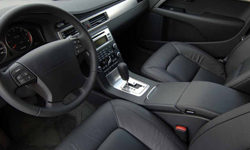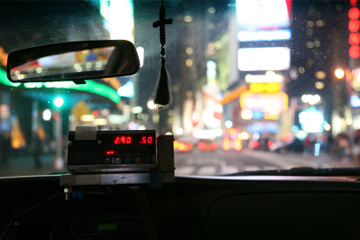 Most cab riders rely on the meter to determine the fare, but don't give a thought to how the meter actually works.
/eye_capture
Most cab riders rely on the meter to determine the fare, but don't give a thought to how the meter actually works.
/eye_capture
If you live in an urban area and frequently use a taxi, you know that dealing with taxi cabs means dealing with a lot of variables. Every time you go for a cab, you have to wonder if the driver will know the best route, if he'll be chatty, if he'll be a safe driver and most importantly, if you'll be able to get a cab at all. As anyone who's ever tried to hail a cab in the rain can tell you, traveling by taxi can sometimes feel like a crap shoot.
But, with all the variables you expect to encounter in a cab, one that most people don't give a thought to is the taxi meter. That little box next to the driver is supposed to be an impartial arbiter of time, distance and cost -- making sure that neither you nor the driver gets ripped off. Most cab riders rely on the meter to determine the fare, but don't give a thought to how the meter actually works.
Understanding how taxi meters works can help put your mind at ease when you take a cab. That's especially true if you travel to cities that you're unfamiliar with. When you travel, a cab driver can be an impromptu tour guide, taking you to local spots that the guide books and most tourists miss. On the other hand, travelers can also feel at the mercy of a cab driver. Knowing how a taxi meter and taxi fares work can help you be your own advocate to make sure that you and the taxi cab driver are treated fairly. Plus, if you know how a taxi meter works, you'll have a nice nugget of information to get a conversation with your driver rolling.
Keep reading to learn how a taxi meter determines your cab fare.
 You can protect yourself from scams by knowing the fare codes for the city you're in and making sure the driver is using the right one.
/Philip Lange
You can protect yourself from scams by knowing the fare codes for the city you're in and making sure the driver is using the right one.
/Philip Lange
One of the advantages of taxi meters is that they provide an accurate measure of what the fare should be. However, that doesn't mean that there aren't ways for taxi drivers to take advantage of their passengers. While the vast majority of cab drivers would never take advantage of a passenger, it pays to be on your guard in case you encounter one of the few drivers who would.
A common taxi driver scam is to get more money from a fare by taking the long way. While that sometimes means taking a less-than-direct route, in egregious cases it can mean driving passengers around in circles. This type of scam usually only works on people who are unfamiliar with the city they're in. If you're traveling, keep a map handy and know the basics of the most direct route for where you want to go. You can even download smartphone apps that calculate the most direct route and let you know what the fare should be.
While taking the long way is a low-tech scam, drivers can also take advantage of passengers by adding surcharges or changing the fare type to one that costs more. Remember how fares that take the cab into Westchester and Nassau Counties from New York City cost double the rate of travel within the city? Fares within the city are Fare Code 1; drivers set the fare code when they pick up passengers. In 2010, New York City officials found that cab drivers had been charging the Nassau and Westchester fare rates for fares in the city by entering Fare Code 4, which tells the meter to calculate the fare at twice the rate for travel within the city. You can protect yourself from scam like this by knowing the fare codes for the city you're in and making sure the driver is using the right one. Fare codes should be posted in the cab. If you feel like the driver is using the wrong code, get their license information (which should also be posted in the cab) and report them to their city's taxi commission.
Taxi meters use objective measures to protect drivers and passengers. As long as you pay attention to the meter and know your rights, there's no reason to worry that your next cab ride will be anything less than wonderful -- assuming, that is, you can find one.

 All taxi meters measure the distance a cab covers, plus any time spent waiting.
/Jeremy Edwards
All taxi meters measure the distance a cab covers, plus any time spent waiting.
/Jeremy Edwards
To put it simply, taxi meters measure distance and time. They then convert those measurements into a fare. Taxi fares are set by the area the taxi cab operates in -- in other words, it might cost more to travel the same distance or time in one city than it does in another. Fares may also change based on how many people are in the taxi, if the driver has to help you with your bags and if the taxi has to cross state or municipal lines to get you where you're going.
No matter where they operate, however, all taxi meters measure the distance a cab covers, plus any time spent waiting. That way, the driver gets compensated for time, so they don't lose out on money just because they're stuck in traffic. It's also why a cab ride from point A to point B may cost you more when there's traffic than when there's not, even if the distance covered is the same.
A taxi meter uses electric pulses to measure both distance and time. To get the distance traveled, the meter relies on a sensor attached to the cab's transmission. The sensor sends an electric pulse to the meter every time the cab travels a given distance. Inside the meter itself is a timer that sends out a pulse when a set amount of time passes. Pulses come from either sensor at intervals that are smaller than the fare interval. For example, a cab might charge you based on every 100 yards (91.4 meters) of travel, but the distance meter will pulse at each yard (0.9 meters). When the meter gets 100 pulses, it adds to the amount of the fare.
Here's an example of fares from New York City. Just hailing a cab and getting in will cost you $2.50. For every fifth of a mile (0.3 kilometers) you travel, 40 cents is added to the fare (a fifth of a mile is four city blocks). For every minute the cab sits without moving, another 40 cents gets added to the fare.
Real traffic conditions aren't that simple, however. In a typical New York cab ride, you'll deal with stop-and-go traffic. To deal with stop-and-go traffic, meters merge calculations from both the time and the distance sensors, counting whichever pulse -- time or distance -- arrives first. Remember, the pulses come more often than the actual distance or wait time. So, if you wait 30 seconds in traffic and then cover two blocks in New York City, the taxi meter will merge the two and add 40 cents to the fare: 20 cents for the distance traveled and 20 cents for the time spent waiting.